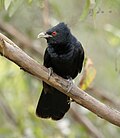
The long-tailed shrike or rufous-backed shrike is a member of the bird family Laniidae, the shrikes. They are found widely distributed across Asia and there are variations in plumage across the range. The species ranges across much of Asia, both on the mainland and the eastern archipelagos. The eastern or Himalayan subspecies, L. s. tricolor, is sometimes called the black-headed shrike. Although there are considerable differences in plumage among the subspecies, they all have a long and narrow black tail, have a black mask and forehead, rufous rump and flanks and a small white patch on the shoulder. It is considered to form a superspecies with the grey-backed shrike which breeds on the Tibetan Plateau.

Cuckoos are birds in the Cuculidae family, the sole taxon in the order Cuculiformes. The cuckoo family includes the common or European cuckoo, roadrunners, koels, malkohas, couas, coucals, and anis. The coucals and anis are sometimes separated as distinct families, the Centropodidae and Crotophagidae, respectively. The cuckoo order Cuculiformes is one of three that make up the Otidimorphae, the other two being the turacos and the bustards. The family Cuculidae contains 150 species, which are divided into 33 genera.
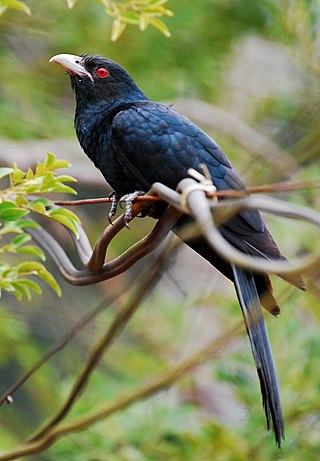
The Asian koel is a member of the cuckoo order of birds, the Cuculiformes. It is found in the Indian Subcontinent, China, and Southeast Asia. It forms a superspecies with the closely related black-billed koels, and Pacific koels which are sometimes treated as subspecies. The Asian koel like many of its related cuckoo kin is a brood parasite that lays its eggs in the nests of crows and other hosts, who raise its young. They are unusual among the cuckoos in being largely frugivorous as adults. The name koel is echoic in origin with several language variants. The bird is a widely used symbol in Indian and Nepali poetry.
The common koels are three species of cuckoos. They have commonly been considered conspecific under the scientific name Eudynamys scolopaceus, but are increasingly treated as separate species:

The red wattlebird is a passerine bird native to southern Australia. At 33–37 cm in length, it is the second largest species of Australian honeyeater. It has mainly grey-brown plumage, with red eyes, distinctive pinkish-red wattles on either side of the neck, white streaks on the chest and a large bright yellow patch on the lower belly. The sexes are similar in plumage. Juveniles have less prominent wattles and browner eyes. John White described the red wattlebird in 1790. Three subspecies are recognized.

The paradise flycatchers (Terpsiphone) are a genus of birds in the family Monarchidae. The genus ranges across Africa and Asia, as well as a number of islands. A few species are migratory, but the majority are resident. The most telling characteristic of the genus is the long tail streamers of the males of many species. In addition to the long tails the males and females are sexually dimorphic and have rufous, black and white plumage.

The blue-faced honeyeater, also colloquially known as the Bananabird, is a passerine bird of the honeyeater family, Meliphagidae. It is the only member of its genus, and it is most closely related to honeyeaters of the genus Melithreptus. Three subspecies are recognised. At around 29.5 cm (11.6 in) in length, the blue-faced species is large for a honeyeater. Its plumage is distinctive, with olive upperparts, white underparts, and a black head and throat with white nape and cheeks. Males and females are similar in external appearance. Adults have a blue area of bare skin on each side of the face readily distinguishing them from juveniles, which have yellow or green patches of bare skin.

The eastern whipbird is an insectivorous passerine bird native to the east coast of Australia. Its whip-crack song is a familiar sound in forests of eastern Australia. Two subspecies are recognised. Heard much more often than seen, it is dark olive-green and black in colour with a distinctive white cheek patch and a crest. The male and female are similar in plumage.
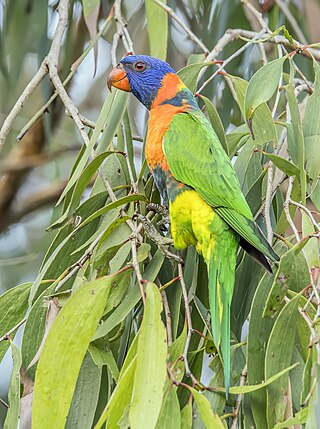
The red-collared lorikeet is a species of parrot found in wooded habitats in northern Australia. It was previously considered a subspecies of the rainbow lorikeet, but today most major authorities consider them as separate species. No other member of the rainbow lorikeet group has an orange-red collar over the nape.

The red-capped robin is a small passerine bird native to Australia. Found in drier regions across much of the continent, it inhabits scrub and open woodland. Like many brightly coloured robins of the family Petroicidae, it is sexually dimorphic. Measuring 10.5–12.5 cm (4.1–4.9 in) in length, the robin has a small, thin, black bill, and dark brown eyes and legs. The male has a distinctive red cap and red breast, black upperparts, and a black tail with white tips. The underparts and shoulders are white. The female is an undistinguished grey-brown. This species uses a variety of songs, and males generally sing to advertise territories and attract females. Birds are encountered in pairs or small groups, but the social behaviour has been little studied.

Horsfield's bronze cuckoo is a small cuckoo in the family Cuculidae. Its size averages 22g and is distinguished by its green and bronze iridescent colouring on its back and incomplete brown barring from neck to tail. Horsfield's bronze cuckoo can be destiguished from other bronze cuckoos by its white eyebrow and brown eye stripe. The Horsfield's bronze cuckoo is common throughout Australia preferring the drier open woodlands away from forested areas.

The black-billed koel is a species of cuckoo in the family Cuculidae. It is endemic to forest and woodland on the Indonesian islands of Sulawesi, Sula, Banggai, Togian and other smaller nearby islands. It has often been considered conspecific with E. scolopaceus, but they are increasingly treated as separate species. Unlike the black-billed koel, all other members of the common koel complex have a pale bill. The black billed koel voice a typical "koel!" call, or a short series of rising and falling "woo" notes.

The Pacific long-tailed cuckoo, also known as the long-tailed cuckoo, long-tailed koel, sparrow hawk, home owl, screecher, screamer or koekoeā in Māori, is a species of the Cuculidae bird family. It is a migratory bird that spends spring and summer in New Zealand, its only breeding place, and spends winter in the Pacific islands. It is a brood parasite, laying its eggs in the nests of other bird species and leaving them to raise its chicks.
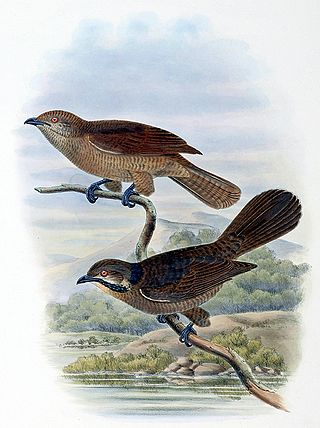
The dwarf koel is a species of cuckoo in the family Cuculidae. It is monotypic within the genus Microdynamis. It is found in New Guinea, where its natural habitat is subtropical or tropical moist lowland forests. Its closest relatives are the Eudynamys.

The thick-billed cuckoo is a species of cuckoo in the family Cuculidae. It is monotypic within the genus Pachycoccyx. It can easily be distinguished from other brood parasitic cuckoo species by its very thick bill, which is shaped in a rather hawk-like fashion.
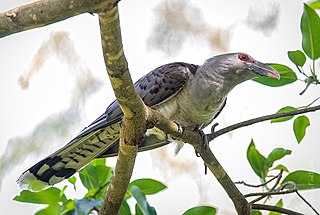
The channel-billed cuckoo is a species of cuckoo in the family Cuculidae. It is monotypic within the genus Scythrops. The species is the largest brood parasite in the world, and the largest cuckoo.

The hooded robin is a small passerine bird native to Australia. Like many brightly coloured robins of the Petroicidae, it is sexually dimorphic; the male bears a distinctive black-and-white plumage, while the female is a nondescript grey-brown.
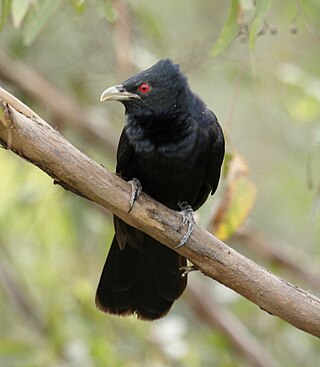
The Pacific koel, also known as the eastern koel or formerly common koel, is a species of cuckoo in the family Cuculidae. In Australia, it is colloquially known as the rainbird or stormbird, as its call is usually more prevalent before or during stormy weather.



